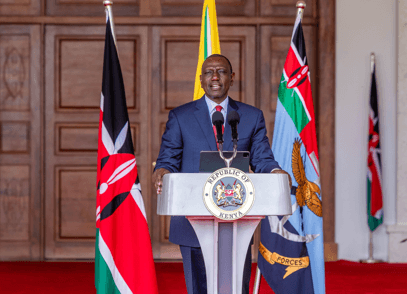Naibunga Upper Community Conservancy sits on a beautiful terrain in Laikipia county.
Its enchanting landscape is covered with rich vegetation, providing a feeling of tranquillity.
Despite this serenity, however, the community here is no longer at ease.
Naibunga Upper Community Conservancy manager Peter Kilua said Opuntia Stricta, a species of large cactus, is giving them sleepless nights.
“It has manifested itself and colonised all the rangelands that we have. Around 70 per cent is colonised by the foreign invasive plant,” he said.
Kilua said they no longer graze their livestock in the affected areas.
This, he said, is because small spikes known as glochids lodge in the mouths, throats, stomachs and intestines of livestock when they eat cactus.
This leaves livestock sick and emaciated and they finally die.
The spikes of the invasive plant also prick the eyes of livestock.
The conservancy covers around 28,000 acres.
The invasive plant has caused massive losses.
“As the challenge grew, the community and the conservancy decided to come together and find the best solution to ensure the plant is eradicated and that there is enough land for grazing and wildlife,” he said.
Kilua said Opuntia prevents anything growing around it and with time, it takes over the rangelands, destroying perennial grasses.
The community members came together in 2019 before introducing the biological control of the invasive plant.
Already, six greenhouses— run by women— have been established around the conservancy to breed cochineal.
Cochineal is a sap-sucking insect.
It sucks fluid from the Opuntia Stricta and once the plant is dead, the insect migrates through wind dispersal to the next plant.
The greenhouses provide conducive breeding for cochineal which was imported from South Africa.
At the conservancy, 120 women work in turns to apply cochineal on the plants.
“We rear the cochineal for three weeks and on the fourth week, we can spread to the fields and we have seen how it sucked the Opuntia,” Kilua said.
They then cut fresh Opuntia to be used again to rear cochineal at the greenhouses.
“That cycle continues until we ensure the invasive species has been eradicated,” he said.
“We have eradicated about 20 per cent of Opuntia,” he said.
The six greenhouses they have are not equivalent to the area already eaten up by the invasive plant.
He said the biological method, though effective, is slow.
After the successful removal of the invasive species, the community plant pasture.
Despite some success, challenges are still many.
The Ipomea invasive species is also rearing its ugly head.
Women say they are pricked by Opuntia as they go about their work as they do not have protective gear such as gloves.
The Nature Conservancy's Northern Kenya conservation coordinator Samson Kuraru said the main drivers of land degradation are persistent drought, poor land management and invasive species.
TNC supports about 45 conservancies in northern Kenya.
“We help them with capacity building to ensure they can speak for themselves,” he said.
The community must be at the centre of all conservation initiatives.
Some of the partners that TNC works with to restore the degraded landscape include NRT, Grevy’s Zebra Trust and Loisaba Conservancy.
One of the interventions that TNC is supporting is effective land use planning at the conservancy level through supporting community governance structures and restoration work.
Kuraru said they are working towards clearing Opuntia through various mechanisms that include biological control and mechanical control.
He said the grass within community conservancies is not sufficient.
“We support the grazing committee through grazing planning in the wet and dry season. They can retain their livestock within a longer time,” he said.
Kuraru said his work is to enhance partnerships.
“TNC is one of the critical partners in this space through funding and technical support. We are also involved directly in some implementation work,” the official said.
Kuraru said they help community conservancies and local communities work towards mitigating the effects of climate change, mainly drought.
He said partners help the communities with interventions, including better governance in community boards and grazing committees.
Northern Rangelands Trust Regional Rangelands coordinator Paul Sosaita said the Naibunga Upper Community Conservancy is also affected by wide galleys.
Sosaita said climate change has made matters worse.
“The galleys have even displaced people,” he said, adding that there is an urgent need for intervention.
Sosaita said even though the community has been trying to prevent water run-off, there is a need to scale up the efforts.
“The rate at which galleys are being formed is fast and it needs a lot of intervention in terms of funding.”
The Naibunga Upper Community Conservancy was among those who made an exhibition during this year’s World Desertification and Drought Day at Nanyuki on June 17.
During the exhibition at Ol Kinyei grounds at Doldol in Nanyuki, Laikipia, county, women showcased how cochineal was dealing a major blow to Opuntia.
It was under the theme ‘united for land. Our legacy. Our future.
During the commemoration, Environment CS Soipan Tuya said a lot of land is degraded.
“According to the Global Land Outlook report of 2022, up to 40 per cent of the planet’s land is degraded which directly affects half of humanity and threatens roughly half of global GDP ($44 trillion)," Tuya said.
"Here in Kenya, the land degradation assessment report of 2016 by the Ministry of Environment and Natural Resources which is the most comprehensive land degradation study, shows about 91 per cent of our country is experiencing some form of land degradation with about 64 per cent experiencing high degradation and 27 per cent severe degradation,” Tuya said.
The CS praised all the initiatives being undertaken by communities to reverse challenges brought about by land degradation.
Tuya said the state is keen to restore all degraded landscapes in the country.














![[PHOTOS] Ole Ntutu’s son weds in stylish red-themed wedding](/_next/image?url=https%3A%2F%2Fcdn.radioafrica.digital%2Fimage%2F2025%2F11%2Ff0a5154e-67fd-4594-9d5d-6196bf96ed79.jpeg&w=3840&q=100)

